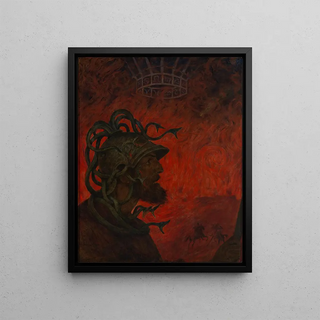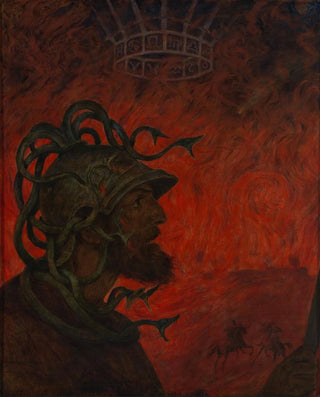Art print | Mars - Hans Thoma


View from behind

Frame (optional)
Reproduction Mars - Hans Thoma – Captivating Introduction
In the vast panorama of art history, certain works manage to transcend their era and capture the collective imagination. "Mars" by Hans Thoma is one of those creations that, through its depth and boldness, evokes a world that is both mythological and contemporary. This painting, embodying the power and beauty of the Roman god of war, invites viewers to explore themes of strength, protection, and the duality of human nature. Contemplating this piece transports one to a universe where the sublime borders on the tragic, where each brushstroke seems to tell a story as old as time itself.
Style and uniqueness of the work
The uniqueness of "Mars" lies in the harmonious fusion of realism and imagination. Thoma, a true master of color, employs a rich and vibrant palette that brings his subject to life. Warm, earthy tones blend with flashes of light, creating an atmosphere that is both intense and serene. The imposing stance of Mars, armed and ready to defend, symbolizes raw strength, while the natural elements surrounding him evoke a deep connection with the earth. This contrast between man and nature, between war and peace, is a defining characteristic of Thoma's work. Every detail, every nuance, is carefully considered to provoke reflection on the human condition and our relationship with violence and beauty.
The artist and his influence
Hans Thoma, an emblematic figure of the symbolist movement and realism, left his mark on his era through an innovative approach to painting. Born in 1839 in Germany, he developed a unique style that blends tradition and modernity, inspired by great masters while seeking to express his own artistic language. Thoma was always fascinated by myths and legends, and "Mars" is a perfect illustration of this. His influence extends far beyond the borders of his homeland, impacting generations of artists who see in him a precursor of a new way to approach painting. Through his work, he questioned conventions while celebrating the beauty of the world, leaving behind an enduring legacy.

Matte finish

View from behind

Frame (optional)
Reproduction Mars - Hans Thoma – Captivating Introduction
In the vast panorama of art history, certain works manage to transcend their era and capture the collective imagination. "Mars" by Hans Thoma is one of those creations that, through its depth and boldness, evokes a world that is both mythological and contemporary. This painting, embodying the power and beauty of the Roman god of war, invites viewers to explore themes of strength, protection, and the duality of human nature. Contemplating this piece transports one to a universe where the sublime borders on the tragic, where each brushstroke seems to tell a story as old as time itself.
Style and uniqueness of the work
The uniqueness of "Mars" lies in the harmonious fusion of realism and imagination. Thoma, a true master of color, employs a rich and vibrant palette that brings his subject to life. Warm, earthy tones blend with flashes of light, creating an atmosphere that is both intense and serene. The imposing stance of Mars, armed and ready to defend, symbolizes raw strength, while the natural elements surrounding him evoke a deep connection with the earth. This contrast between man and nature, between war and peace, is a defining characteristic of Thoma's work. Every detail, every nuance, is carefully considered to provoke reflection on the human condition and our relationship with violence and beauty.
The artist and his influence
Hans Thoma, an emblematic figure of the symbolist movement and realism, left his mark on his era through an innovative approach to painting. Born in 1839 in Germany, he developed a unique style that blends tradition and modernity, inspired by great masters while seeking to express his own artistic language. Thoma was always fascinated by myths and legends, and "Mars" is a perfect illustration of this. His influence extends far beyond the borders of his homeland, impacting generations of artists who see in him a precursor of a new way to approach painting. Through his work, he questioned conventions while celebrating the beauty of the world, leaving behind an enduring legacy.






